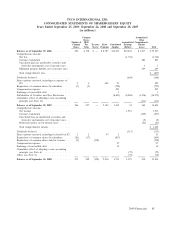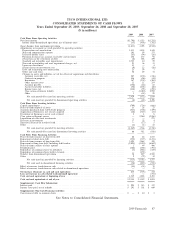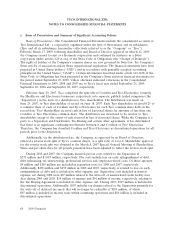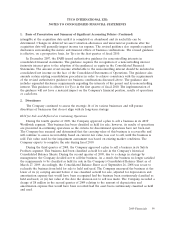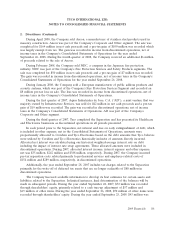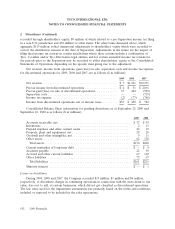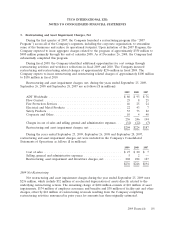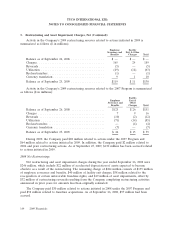ADT 2009 Annual Report Download - page 186
Download and view the complete annual report
Please find page 186 of the 2009 ADT annual report below. You can navigate through the pages in the report by either clicking on the pages listed below, or by using the keyword search tool below to find specific information within the annual report.TYCO INTERNATIONAL LTD.
NOTES TO CONSOLIDATED FINANCIAL STATEMENTS
1. Basis of Presentation and Summary of Significant Accounting Policies (Continued)
Effective as of the beginning of the third quarter of 2007, Tyco changed the estimated useful life of
dealer intangibles in geographical areas comprising approximately 90% of the net carrying value of
dealer intangibles from 12 to 15 years. The Company continues to amortize dealer intangible assets on
an accelerated basis. The change in the estimated useful life used to account for dealer intangibles
resulted from our ongoing analysis of all pertinent factors, including actual customer attrition data,
demand, competition, and the estimated technological life of the installed systems. The pertinent
factors have been influenced by management’s ongoing customer retention programs, as well as tactical
and strategic initiatives to improve service delivery, customer satisfaction, and the credit worthiness of
the subscriber customer base. The change in estimated useful life of dealer intangibles has been
accounted for prospectively. The effect of the change in estimated useful life for dealer intangibles
decreased loss from continuing operations and net loss by $6 million each and increased basic and
diluted earnings per share by $0.01 for 2007.
Other contracts and related customer relationships, as well as intellectual property consisting
primarily of patents, trademarks, copyrights and unpatented technology, are amortized on a straight-line
basis over 4 to 40 years. The Company evaluates the amortization methods and remaining useful lives
of intangible assets on a periodic basis to determine whether events and circumstances warrant a
revision to the amortization method or remaining useful lives.
Investments—The Company invests in debt and equity securities. Long-term investments in
marketable equity securities that represent less than twenty percent ownership are marked to market at
the end of each accounting period. Unrealized gains and losses are credited or charged to accumulated
other comprehensive (loss) income within shareholders’ equity for available for sale securities unless an
unrealized loss is deemed to be other than temporary, in which case such loss is charged to earnings.
Management determines the proper classification of investments in debt obligations with fixed
maturities and equity securities for which there is a readily determinable market value at the time of
purchase and reevaluates such classifications as of each balance sheet date. Realized gains and losses
on sales of investments are included in the Consolidated Statements of Operations.
Other equity investments for which the Company does not have the ability to exercise significant
influence and for which there is not a readily determinable market value are accounted for under the
cost method of accounting. Each reporting period, the Company evaluates the carrying value of its
investments accounted for under the cost method of accounting, such that they are recorded at the
lower of cost or estimated net realizable value. For equity investments in which the Company exerts
significant influence over operating and financial policies but do not control, the equity method of
accounting is used. The Company’s share of net income or losses of equity investments is included in
the Consolidated Statements of Operations and was not material in any period presented.
Product Warranty—The Company records estimated product warranty costs at the time of sale.
Products are warranted against defects in material and workmanship when properly used for their
intended purpose, installed correctly, and appropriately maintained. Generally, product warranties are
implicit in the sale; however, the customer may purchase an extended warranty. However, in most
instances the warranty is either negotiated in the contract or sold as a separate component. Warranty
period terms range from 90 days up to 15 years. The warranty liability is determined based on historical
information such as past experience, product failure rates or number of units repaired, estimated cost
of material and labor, and in certain instances estimated property damage.
94 2009 Financials



